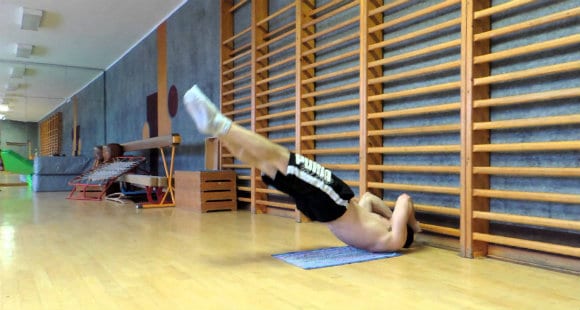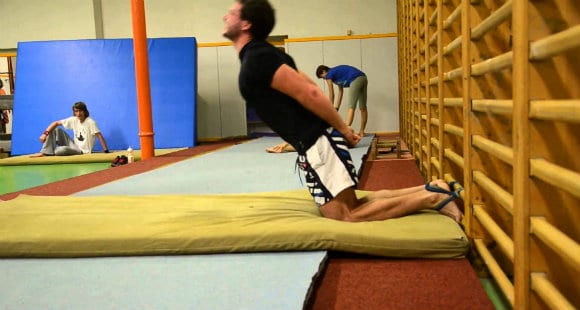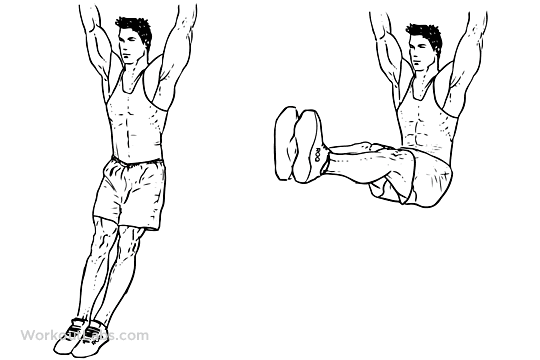By the healthiergang writer , student in Physiotherapy.
Backrest Swedish Exercises
The Swedish wall bars (or simply wall bars) are a fairly common tool in athletics and other gymnastic sports gyms. If it is not clear what they are, they are that sort of wooden ladder that is more than three times the size of a normal ladder.
This tool can also be very useful in a gym more focused on body building. In fact, with the Swedish wall bars you can do many exercises and stretching that have a positive impact on your body and on your athletic abilities.
The exercises we are talking about are exercises that employ the weight of your body, a sort of calisthenics exercises.
1. Dragon Flag
This exercise is excellent to perform with the help of the backrests.
What limits the ability to perform a good Dragon Flag is the lack of a low bar to hold onto with your hands.
The Swedish wall bars are ideal.
Position yourself lying down with your back on the ground near a horizontal bar of the backrest. Prune your elbows above your head and grasp the wooden bar with your hands.
At this point the Dragon Flag can be performed. To perform this exercise, it is important to keep the entire body contracted, focusing on the glutes, abdominals and obliques.
The arms must constantly maintain tension, as if you were doing a pullover with the handlebar in isometry. The weight should always rest on the upper back and this should be the only area in contact with the ground.
Once you have brought your feet upwards, come down in a controlled manner and inhale.

You must always maintain complete alignment of the body segments and never lose the "hollow" position (back straight while keeping the abdominals contracted). Arrived practically with the legs parallel to the floor, return to the starting position by guiding the movement with the pelvis.
This means that you have to keep the buttocks contracted and raise the whole body from the shoulders down at the same time. It is as if the body were performing a leg laugh at the bar but using the upper back as the sole point of contact with the ground. The neck must always maintain a neutral position and in the eccentric phase inhale and in the concentric phase exhale.
2. Glute Ham Raise
The limiting factor for performing a good Glute Ham Raise is the same as for the previous exercise. Some gyms have the appropriate equipment but many do not. The Glute Ham Raise is a great, if not the best, exercise for training the hamstring muscles.
These muscles are the semitendinosus and the semimembranosus, located in the medial area of the thigh, and the hamstring muscle located in the lateral area of the thigh.
The hamstring has two heads: the long head that fits on the pelvis and the short head that is mono-articular.
The medial hamstring is also bi-articular. This means that the long head of the hamstring, the semitendinosus and the semimembranous have the function of extending the pelvis and flexing the knee while the short head of the hamstring has only the function of flexing the knee (in reality these muscles also have other stabilization functions).
Knowing a little more about the anatomy of the hamstrings can help you get better results from the Glute Ham Raise.
To focus more on the medial hamstring, it is necessary to keep the knees internally rotated, to go down while maintaining a slight flexion of the pelvis and in the final phase of the exercise to fully flex the leg and at the same time extend the pelvis by contracting the buttocks.
To focus on the hamstring, keep the knee extra rotated.
To accentuate the effort of the long head, perform the movement with a slight flexion of the pelvis and then extend it in the phase of maximum contraction.
To facilitate the recruitment of the short head, keep the pelvis extended, then the buttocks contracted, during the entire movement.
The advantage of the Swedish wall bars is that you can manipulate the positioning of the knees without complications and still maintain a firm position.

3. Leg Raise
It is useful to perform the leg raise holding on to the back rests because in the initial contraction phase the back is forced to stay straight against the back rest. This means that you are less inclined to use the moment created with your own legs and therefore tend to recruit the abs more.

The bar leg raise is one of the best ab exercises but often turns into a competition to see who can do the most reps. With the use of the shoulder bars, it is possible to work more on the quality of the repetitions, an important factor in training the abdominals.


























